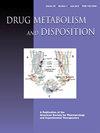3-epi-18β-甘草次酸或其葡萄糖醛酸苷--甘草次酸的代谢物具有个体差异,与甘草诱发的人类假性醛固酮增多症的诊断结果相关联
IF 4.4
3区 医学
Q1 PHARMACOLOGY & PHARMACY
引用次数: 0
摘要
甘草是一种粗制药物,用于日本传统的神保医药,也可用作甜味剂。它的副作用偶尔会导致假性醛固酮增多症(PsA)。主要症状包括低钾血症、高血压、水肿和血浆醛固酮水平低。PsA 可能是由甘草的一种成分甘草次酸(GL)的代谢产物引起的。PsA 的发病因人而异,但导致个体差异的因素仍不清楚。本研究招募了 78 名服用含甘草的康普药物的患者,并评估了他们的实验室数据,包括血清钾水平、血浆醛固酮浓度(PAC)以及残留血样和/或尿样中甘草酸代谢物的浓度。在 78 名参与者中,分别有 65、47、63、62 和 3 名参与者的血清样本中检测到 18β-甘草亭酸(GA)、3-epi-GA、3-oxo-GA、18β-甘草亭基-30-O-葡萄糖醛酸(GA30G)和 3-epi-GA30G。在收集的 29 份尿液样本中,分别有 27 份和 19 份检测到 GA30G 和 3-epi-GA30G。3-epi-GA30G 是一种新发现的 GL 代谢物。此外,3-epi-GA、3-oxo-GA 和 3-epi-GA30G 也是首次在人体样本中发现。研究发现,血清中的 3-epi-GA 和尿液中的 3-epi-GA30G 存在很大的个体差异,这些代谢物的浓度与血清中的 PsA 标志物相关。3-epi-GA、3-oxo-GA、GA30G和3-epi-GA30G对人体11β-羟类固醇脱氢酶2型(11β-HSD2)的抑制滴度几乎相似。这些发现表明,3-epi-GA和/或3-epi-GA30G与PsA发病的个体差异有关。本文章由计算机程序翻译,如有差异,请以英文原文为准。
3-epi-18β-glycyrrhetinic acid or its glucuronide, the metabolites of glycyrrhizinic acid with individual differences, correlated with diagnostic maker for licorice-induced pseudoaldosteronism in humans
Licorice is a crude drug that is used in traditional Japanese Kampo medicine and is also used as a sweetener. Occasionally, it causes pseudoaldosteronism (PsA) as a side effect. The major symptoms include hypokalemia, hypertension, edema, and low plasma aldosterone levels. PsA might be caused by the metabolites of glycyrrhizinic acid (GL), a component of licorice. The development of PsA markedly varies among individuals; however, the factors that cause these individual differences remain unknown. In this study, 78 patients who consumed Kampo medicines containing licorice were enrolled, and their laboratory data, including serum potassium levels, plasma aldosterone concentrations (PAC), and the concentrations of GL metabolites in the residual blood and/or urine samples were evaluated. Of the 78 participants, 18β-glycyrrhetinic acid (GA), 3-epi-GA, 3-oxo-GA, 18β-glycyrrhetinyl-30-O-glucuronide (GA30G), and 3-epi-GA30G were detected in the serum samples of 65, 47, 63, 62, and 3 participants, respectively. Of the 29 urine samples collected, GA30G and 3-epi-GA30G were detected in 27 and 19 samples. 3-epi-GA30G is a newly found GL metabolite. Moreover, 3-epi-GA, 3-oxo-GA, and 3-epi-GA30G were identified in human samples for the first time. High individual differences were found in the appearances of 3-epi-GA in serum and 3-epi-GA30G in urine, and the concentrations of these metabolites were correlated with serum PsA markers. The inhibitory titers of 3-epi-GA, 3-oxo-GA, GA30G, and 3-epi-GA30G on human 11β-hydroxysteroid dehydrogenase type 2 (11β-HSD2) were almost similar. These findings suggest that 3-epi-GA and/or 3-epi-GA30G are associated with individual differences in the development of PsA.
求助全文
通过发布文献求助,成功后即可免费获取论文全文。
去求助
来源期刊
CiteScore
6.50
自引率
12.80%
发文量
128
审稿时长
3 months
期刊介绍:
An important reference for all pharmacology and toxicology departments, DMD is also a valuable resource for medicinal chemists involved in drug design and biochemists with an interest in drug metabolism, expression of drug metabolizing enzymes, and regulation of drug metabolizing enzyme gene expression. Articles provide experimental results from in vitro and in vivo systems that bring you significant and original information on metabolism and disposition of endogenous and exogenous compounds, including pharmacologic agents and environmental chemicals.

 求助内容:
求助内容: 应助结果提醒方式:
应助结果提醒方式:


